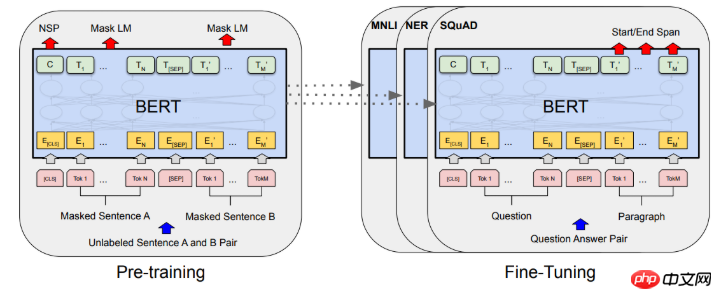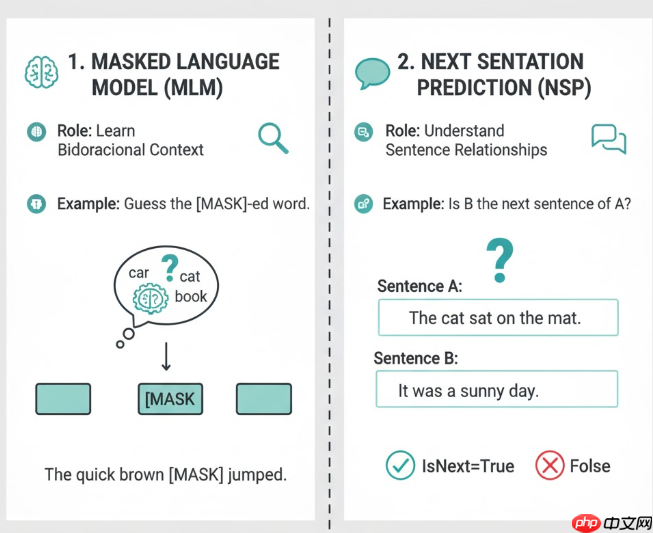✍ 本专题假设读者已经具备一定的深度学习与 transformer 基础,目标是帮助读者系统地复习 bert 模型的核心设计思想与常见面试问法。本专题来源于本人在面试 nlp / llm / 多模态预训练相关岗位时的真实问题与个人总结,本章的重点是为什么gpt的【mask】设计会导致数据泄露?为什么bert在取代【mask】保留原词的时候就不会导致数据泄露?等比较深入的问题
BERT 全称为 Bidirectional Encoder Representations from Transformers,由 Google AI 在 2018 年提出,奠定了后续预训练语言模型(PLM)发展的基石。
?️ 论文地址:arxiv地址
BERT与Transformer不同,和GPT一样沿用了Transformer的基本架构, 不同的是,BERT是基于 Transformer Encoder 堆叠的模型,舍弃了 Transformer 的 Decoder,仅保留 Encoder 部分, 是一个堆叠了 $L$ 层 Encoder 的纯 Transformer 编码器模型。作者提出了两个大小的BERT模型:
模型 |
层数 (L) |
隐层维度 (H) |
注意力头数 (A) |
参数量 |
备注 |
|---|---|---|---|---|---|
BERT Base |
12 |
768 |
12 |
~110M |
与GPT大小相同 |
BERT Large |
24 |
1024 |
16 |
~340M |
更高表达力,训练更慢 |
☞☞☞AI 智能聊天, 问答助手, AI 智能搜索, 免费无限量使用 DeepSeek R1 模型☜☜☜

代表模型 |
方向 |
任务类型 |
优势 |
劣势 |
|---|---|---|---|---|
BERT, RoBERTa |
Encoder-only |
理解(分类、匹配、QA) |
双向上下文、语义表达强 |
无法生成、mask训练慢 |
GPT serious |
Decoder-only |
生成(文本生成、对话) |
自回归生成自然、训练目标简单 |
单向建模、理解弱 |
Transformer, T5, BART |
Encoder–Decoder |
理解+生成(摘要、翻译) |
二者兼顾,可用于指令模型 |
训练/推理复杂度高 |
BERT对于初学者来说,好像也是一个生成任务,但实际上,BERT是在做一个完形填空的任务。
? 举个例子:
→ BERT 能预测“机器”
输入:我爱学习
→ BERT 无法生成接下来的“因为我有热情”,因为它没有解码器。
因此,BERT 的 MLM 任务确实有“生成”行为,但它并不是自回归意义上的生成模型。 它预测被mask的token,而不是像GPT一样输入一个句子,依次生成一个完整的句子。
BERT 的训练分为两个阶段:
预训练(Pre-training):在大规模无监督语料上进行语言建模任务学习。下游微调(Fine-tuning):在下游任务(分类、问答、序列标注等)上,用任务特定的输入格式(加上[CLS]、[SEP] 标志),再加上一个小的输出层。
在面试过程中,只要你的简历上涉及到了BERT,BERT一定会问你一个问题:
任务 |
缩写 |
作用 
PHP高级程序设计 模式 框架与测试(中文高清PDF版)
查看详情
享有盛誉的PHP高级教程,Zend Framework核心开发人员力作,深入设计模式、PHP标准库和JSON 。 今天,PHP已经是无可争议的Web开发主流语言。PHP 5以后,它的面向对象特性也足以与Java和C#相抗衡。然而,讲述PHP高级特性的资料一直缺乏,大大影响了PHP语言的深入应用。 本书填补了这一空白。它专门针对有一定经验的PHP程序员,详细讲解了对他们最为重要的主题  455
455

|
举例 |
|---|---|---|---|
Masked Language Model |
MLM |
学习双向上下文 |
猜被 MASK 的词 |
Next Sentence Prediction |
NSP |
学习句子间关系 |
判断 B 是不是 A 的下一句 |

传统的语言模型(例如 GPT)是条件概率建模,
$$P(x1, x_2, ..., x_n) = \prod{t=1}^{n} P(xt | x_1, ..., x{t-1})$$
也就是逐词预测下一个 token。这乍一看好像也可以实现双向,假设我们想让模型学:
$$P(xt | x_1, ..., x{t-1}, x_{t+1}, ..., x_n)$$
也就是同时看到左右上下文。但问题是:如果模型的多层 self-attention 可以访问所有位置的信息,通过其他 token 的上下文聚合,模型仍然可能在深层“绕回来”获取自己的信息, “间接地”访问到自己的真实词。
? 举个例子:
Layer 1: "love" attends to "I" and "NLP"
Layer 2: "NLP" attends back to "love"
这样“love”通过“间接路径”又拿到了自己的 embedding,
因此,BERT 引入了 Masked Language Modeling (MLM) 预训练目标,让模型能够同时看到 左右上下文。在预训练时,BERT会随机遮蔽输入序列中 15% 的 token. (其中有80%被替换为MASK, 10% 替换为随机词, 10% 保留原词)任务是预测被遮蔽的词:
模型通过上下文(左右两侧)推测被 Mask 的词,因此学习到双向语义信息。
下游任务的输入从来没有 [MASK]。但如果预训练时几乎所有预测目标都依赖 [MASK] 特征,模型就会学会“见到 [MASK] 才认真预测”,而当 fine-tune 阶段没有 [MASK] 时,它的表现会退化。这样做是为了防止模型过度依赖 [MASK] 符号,增强鲁棒性。
学到这里,可能有些读者就有些疑惑了,为什么这里就可以保留原词了呢?保留原词不就又导致数据泄露了吗?如果你有此疑问,可以继续看下去。
BERT 的整体过程是这样的:
先随机选出 15% 的 token → 这些位置是“潜在的预测目标”。loss 只计算在这 15% 的位置上。模型虽然“输入里看到 love”,但它并不知道 “love” 是要被预测的位置。所以它的“泄露”是表层信息流的可见,而非训练信号(loss 反传)层面的泄露。
NSP任务是判断 B 是不是 A 的下一句:
输入A |
输入B |
标签 |
|---|---|---|
I went to the store. |
I bought some milk. |
IsNext |
I went to the store. |
Penguins live in Antarctica. |
NotNext |
其中50% 的样本中,B 是 A 的真实下一句;50% 是随机句子;BERT 输入由两句话拼接而成,用 [SEP] 分隔:
模型通过 [CLS] 向量预测是否为“下一句”。

NSP 想让模型不仅理解句内词之间的关系, 还要理解句与句之间的语义连续性(discourse-level coherence)。
后续实验(尤其是 RoBERTa 和 ALBERT)发现 NSP 的问题主要有两点:
① 任务过于简单 :随机拼句 vs. 连续句 这个二分类太容易。模型可以仅靠表面统计特征(比如主题词、长度、标点)来判断,而非真正理解上下文。
② 难以泛化到真实句间关系任务:下游任务(如 QA、NLI)要求模型理解 逻辑推理(entailment、contradiction、causality),但 NSP 学到的只是“句子 A 和句子 B 是否相邻”
模型 |
NSP 是否保留 |
替代机制 |
|---|---|---|
RoBERTa |
❌ 去掉 NSP |
用更长连续文本训练(512 tokens),依赖 MLM 自行捕获句间依存 |
ALBERT |
✅ 改进 |
引入 SOP(Sentence Order Prediction):判断两句是否调换顺序,更关注语义连贯性 |
ELECTRA |
❌ 去掉 NSP |
改为 RTD(Replaced Token Detection),更细粒度的预训练信号 |
<code class="python">class BertSelfAttention(nn.Module): def __init__(self, hidden_dim, num_heads, dropout=0.1): super().__init__() assert hidden_dim % num_heads == 0 self.num_heads = num_heads self.head_dim = hidden_dim // num_heads self.query = nn.Linear(hidden_dim, hidden_dim) self.key = nn.Linear(hidden_dim, hidden_dim) self.value = nn.Linear(hidden_dim, hidden_dim) self.dropout = nn.Dropout(dropout) def _transpose_for_scores(self, x): """ [B, L, H] -> [B, h, L, d] """ B, L, H = x.size() x = x.view(B, L, self.num_heads, self.head_dim) return x.permute(0, 2, 1, 3) # [B, h, L, d] def forward(self, hidden_states, attention_mask=None): """ hidden_states: [B, L, H] attention_mask: [B, 1, 1, L] (1 保留, 0 mask) """ Q = self._transpose_for_scores(self.query(hidden_states)) K = self._transpose_for_scores(self.key(hidden_states)) V = self._transpose_for_scores(self.value(hidden_states)) # [B, h, L, L] scores = torch.matmul(Q, K.transpose(-1, -2)) / (self.head_dim ** 0.5) if attention_mask is not None: # 将 mask 为 0 的位置置为 -inf,softmax 后概率为 0 scores = scores.masked_fill(attention_mask == 0, float("-inf")) attn_probs = F.softmax(scores, dim=-1) attn_probs = self.dropout(attn_probs) # [B, h, L, d] context = torch.matmul(attn_probs, V) # -> [B, L, H] context = context.permute(0, 2, 1, 3).contiguous() B, L, h, d = context.size() context = context.view(B, L, h * d) return context, attn_probsclass BertSelfOutput(nn.Module): def __init__(self, hidden_dim, dropout=0.1): super().__init__() self.dense = nn.Linear(hidden_dim, hidden_dim) self.layer_norm = nn.LayerNorm(hidden_dim) self.dropout = nn.Dropout(dropout) def forward(self, hidden_states, input_tensor): """ hidden_states: self-attention 输出 [B, L, H] input_tensor: 残差输入 [B, L, H] """ x = self.dense(hidden_states) x = self.dropout(x) return self.layer_norm(x + input_tensor)class BertIntermediate(nn.Module): def __init__(self, hidden_dim, intermediate_dim, activation="gelu"): super().__init__() self.dense = nn.Linear(hidden_dim, intermediate_dim) if activation == "relu": self.act_fn = F.relu else: # 默认 GELU self.act_fn = F.gelu def forward(self, x): return self.act_fn(self.dense(x))class BertOutput(nn.Module): def __init__(self, hidden_dim, intermediate_dim, dropout=0.1): super().__init__() self.dense = nn.Linear(intermediate_dim, hidden_dim) self.layer_norm = nn.LayerNorm(hidden_dim) self.dropout = nn.Dropout(dropout) def forward(self, hidden_states, input_tensor): x = self.dense(hidden_states) x = self.dropout(x) return self.layer_norm(x + input_tensor)class BertLayer(nn.Module): """ 一个完整的 BERT Encoder 层: Self-Attention -> Add & Norm -> FFN -> Add & Norm """ def __init__(self, hidden_dim, num_heads, intermediate_dim, dropout=0.1): super().__init__() self.attention = BertSelfAttention(hidden_dim, num_heads, dropout) self.attention_output = BertSelfOutput(hidden_dim, dropout) self.intermediate = BertIntermediate(hidden_dim, intermediate_dim) self.output = BertOutput(hidden_dim, intermediate_dim, dropout) def forward(self, hidden_states, attention_mask=None): # Self-Attention attn_output, _ = self.attention(hidden_states, attention_mask) hidden_states = self.attention_output(attn_output, hidden_states) # FFN intermediate_output = self.intermediate(hidden_states) layer_output = self.output(intermediate_output, hidden_states) return layer_output</code><code class="python">class BertEncoder(nn.Module): def __init__(self, num_layers, hidden_dim, num_heads, intermediate_dim, dropout=0.1): super().__init__() self.layers = nn.ModuleList([ BertLayer(hidden_dim, num_heads, intermediate_dim, dropout) for _ in range(num_layers) ]) def forward(self, hidden_states, attention_mask=None): # 简化版:只返回最后一层的输出 for layer in self.layers: hidden_states = layer(hidden_states, attention_mask) return hidden_statesclass BertPooler(nn.Module): """ Pooler:取 [CLS] 位置的向量,过一层全连接 + tanh """ def __init__(self, hidden_dim): super().__init__() self.dense = nn.Linear(hidden_dim, hidden_dim) def forward(self, hidden_states): # 假设 input_ids 的第一个 token 是 [CLS] cls_token = hidden_states[:, 0] # [B, H] pooled = torch.tanh(self.dense(cls_token)) return pooledclass BertModel(nn.Module): """ 一个最小可用的 BERT 模型: Embedding -> Encoder(L 层) -> Pooler """ def __init__( self, vocab_size, hidden_dim=768, num_layers=12, num_heads=12, intermediate_dim=3072, max_len=512, segment_size=2, dropout=0.1, ): super().__init__() self.embeddings = BertEmbedding( vocab_size=vocab_size, hidden_dim=hidden_dim, max_len=max_len, segment_size=segment_size, ) self.encoder = BertEncoder( num_layers=num_layers, hidden_dim=hidden_dim, num_heads=num_heads, intermediate_dim=intermediate_dim, dropout=dropout, ) self.pooler = BertPooler(hidden_dim) def forward(self, input_ids, token_type_ids, attention_mask=None): """ input_ids: [B, L] token_type_ids: [B, L] (segment id / sentence A/B) attention_mask: [B, L] (1 表示真实 token, 0 表示 padding) """ # [B, L, H] hidden_states = self.embeddings(input_ids, token_type_ids) if attention_mask is not None: # [B, 1, 1, L],方便广播到 [B, h, L, L] attention_mask = attention_mask[:, None, None, :] # Encoder sequence_output = self.encoder(hidden_states, attention_mask) # Pooler pooled_output = self.pooler(sequence_output) return sequence_output, pooled_output</code>
<code class="python">class MaskedLanguageModel(nn.Module): """ 对被 mask 的位置做 token 分类: hidden_states: [B, L, H] masked_positions: [B, M] (每个样本 M 个 mask 位置,不足用 -1 填充) """ def __init__(self, vocab_size, hidden_dim): super().__init__() self.transform = nn.Linear(hidden_dim, hidden_dim) self.layer_norm = nn.LayerNorm(hidden_dim) self.decoder = nn.Linear(hidden_dim, vocab_size, bias=False) def forward(self, hidden_states, masked_positions): B, L, H = hidden_states.size() # masked_positions: [B, M],其中 -1 表示“无效” # 构造 batch 维索引 batch_idx = torch.arange(B, device=hidden_states.device).unsqueeze(1) # [B, 1] # 为避免 -1 索引越界,先 clamp 到 [0, L-1],后面通过 label mask 掩掉 pos = masked_positions.clamp(min=0) # [B, M, H] masked_hidden = hidden_states[batch_idx, pos] x = F.gelu(self.transform(masked_hidden)) x = self.layer_norm(x) logits = self.decoder(x) # [B, M, vocab_size] return logitsclass NextSentencePrediction(nn.Module): def __init__(self, hidden_dim): super().__init__() self.linear = nn.Linear(hidden_dim, 2) def forward(self, cls_vector): # cls_vector: [B, H] return self.linear(cls_vector) # [B, 2]class BertForPreTraining(nn.Module): """ BERT 预训练模型:BertModel + MLM + NSP """ def __init__(self, vocab_size, hidden_dim=768, **kwargs): super().__init__() self.bert = BertModel( vocab_size=vocab_size, hidden_dim=hidden_dim, **kwargs, ) self.mlm_head = MaskedLanguageModel(vocab_size, hidden_dim) self.nsp_head = NextSentencePrediction(hidden_dim) def forward( self, input_ids, token_type_ids, attention_mask, masked_positions, masked_lm_labels=None, # [B, M],无效位置用 -100 next_sentence_labels=None, # [B] ): sequence_output, pooled_output = self.bert( input_ids=input_ids, token_type_ids=token_type_ids, attention_mask=attention_mask, ) # MLM 预测 prediction_scores = self.mlm_head(sequence_output, masked_positions) # NSP 预测 seq_relationship_score = self.nsp_head(pooled_output) outputs = (prediction_scores, seq_relationship_score) # 如传入 label,则计算 loss if masked_lm_labels is not None and next_sentence_labels is not None: # MLM loss mlm_loss_fct = nn.CrossEntropyLoss(ignore_index=-100) # [B * M, vocab_size] vs [B * M] mlm_loss = mlm_loss_fct( prediction_scores.view(-1, prediction_scores.size(-1)), masked_lm_labels.view(-1), ) # NSP loss nsp_loss_fct = nn.CrossEntropyLoss() nsp_loss = nsp_loss_fct( seq_relationship_score.view(-1, 2), next_sentence_labels.view(-1), ) total_loss = mlm_loss + nsp_loss outputs = (total_loss, mlm_loss, nsp_loss) + outputs return outputs # (loss, mlm_loss, nsp_loss, prediction_scores, seq_relationship_score)</code>
<code class="python">def create_masked_lm_labels( input_ids, pad_token_id, cls_token_id, sep_token_id, mask_token_id, vocab_size, mlm_probability=0.15, max_masks_per_seq=20,): """ 根据 BERT 规则构造 MLM 输入和标签: - 15% token 作为预测目标 - 80% -> [MASK] - 10% -> 随机词 - 10% -> 保留原词 返回: masked_input_ids: [B, L] masked_lm_labels: [B, M],非 mask 位置填 -100 masked_positions: [B, M],不足部分填 -1 """ device = input_ids.device B, L = input_ids.size() # 1. 初始化 masked_input_ids = input_ids.clone() masked_lm_labels = torch.full( (B, max_masks_per_seq), -100, dtype=torch.long, device=device ) masked_positions = torch.full( (B, max_masks_per_seq), -1, dtype=torch.long, device=device ) # 预先生成随机数 prob = torch.rand_like(input_ids.float()) # 构建不能被 mask 的位置(特殊符号和 padding) special_mask = ( (input_ids == pad_token_id) | (input_ids == cls_token_id) | (input_ids == sep_token_id) ) # 选出真正被选为 mask 候选的 token mask_candidate = (prob < mlm_probability) & (~special_mask) for b in range(B): candidate_indices = torch.nonzero(mask_candidate[b], as_tuple=False).view(-1) # 限制最多 mask 的个数 if len(candidate_indices) > max_masks_per_seq: chosen = candidate_indices[torch.randperm(len(candidate_indices))[:max_masks_per_seq]] else: chosen = candidate_indices if len(chosen) == 0: continue # 记录这些位置的 label masked_lm_labels[b, : len(chosen)] = input_ids[b, chosen] masked_positions[b, : len(chosen)] = chosen # 80% -> [MASK] num_mask = len(chosen) num_mask_mask = int(num_mask * 0.8) num_mask_random = int(num_mask * 0.1) # 剩余 10% 保留原词 perm = torch.randperm(num_mask) mask_idx = chosen[perm[:num_mask_mask]] random_idx = chosen[perm[num_mask_mask : num_mask_mask + num_mask_random]] # keep_idx = chosen[perm[num_mask_mask + num_mask_random:]] # 替换为 [MASK] masked_input_ids[b, mask_idx] = mask_token_id # 替换为随机词 if len(random_idx) > 0: random_words = torch.randint( low=0, high=vocab_size, size=(len(random_idx),), device=device ) masked_input_ids[b, random_idx] = random_words # 剩下的 10% 保留原词,不需要改 masked_input_ids return masked_input_ids, masked_lm_labels, masked_positions</code>
<code class="python">def pretrain_step( model: BertForPreTraining, batch, optimizer, pad_token_id, cls_token_id, sep_token_id, mask_token_id, vocab_size, device="cuda",): model.train() input_ids = batch["input_ids"].to(device) # [B, L] token_type_ids = batch["token_type_ids"].to(device) # [B, L] attention_mask = batch["attention_mask"].to(device) # [B, L] next_sentence_labels = batch["next_sentence_labels"].to(device) # [B] # 构造 MLM 目标 masked_input_ids, masked_lm_labels, masked_positions = create_masked_lm_labels( input_ids=input_ids, pad_token_id=pad_token_id, cls_token_id=cls_token_id, sep_token_id=sep_token_id, mask_token_id=mask_token_id, vocab_size=vocab_size, ) masked_input_ids = masked_input_ids.to(device) masked_lm_labels = masked_lm_labels.to(device) masked_positions = masked_positions.to(device) outputs = model( input_ids=masked_input_ids, token_type_ids=token_type_ids, attention_mask=attention_mask, masked_positions=masked_positions, masked_lm_labels=masked_lm_labels, next_sentence_labels=next_sentence_labels, ) total_loss, mlm_loss, nsp_loss = outputs[:3] optimizer.zero_grad() total_loss.backward() optimizer.step() return { "loss": total_loss.item(), "mlm_loss": mlm_loss.item(), "nsp_loss": nsp_loss.item(), }</code>以上就是【多模态大模型面经】 BERT 专题面经的详细内容,更多请关注php中文网其它相关文章!

每个人都需要一台速度更快、更稳定的 PC。随着时间的推移,垃圾文件、旧注册表数据和不必要的后台进程会占用资源并降低性能。幸运的是,许多工具可以让 Windows 保持平稳运行。

Copyright 2014-2025 https://www.php.cn/ All Rights Reserved | php.cn | 湘ICP备2023035733号